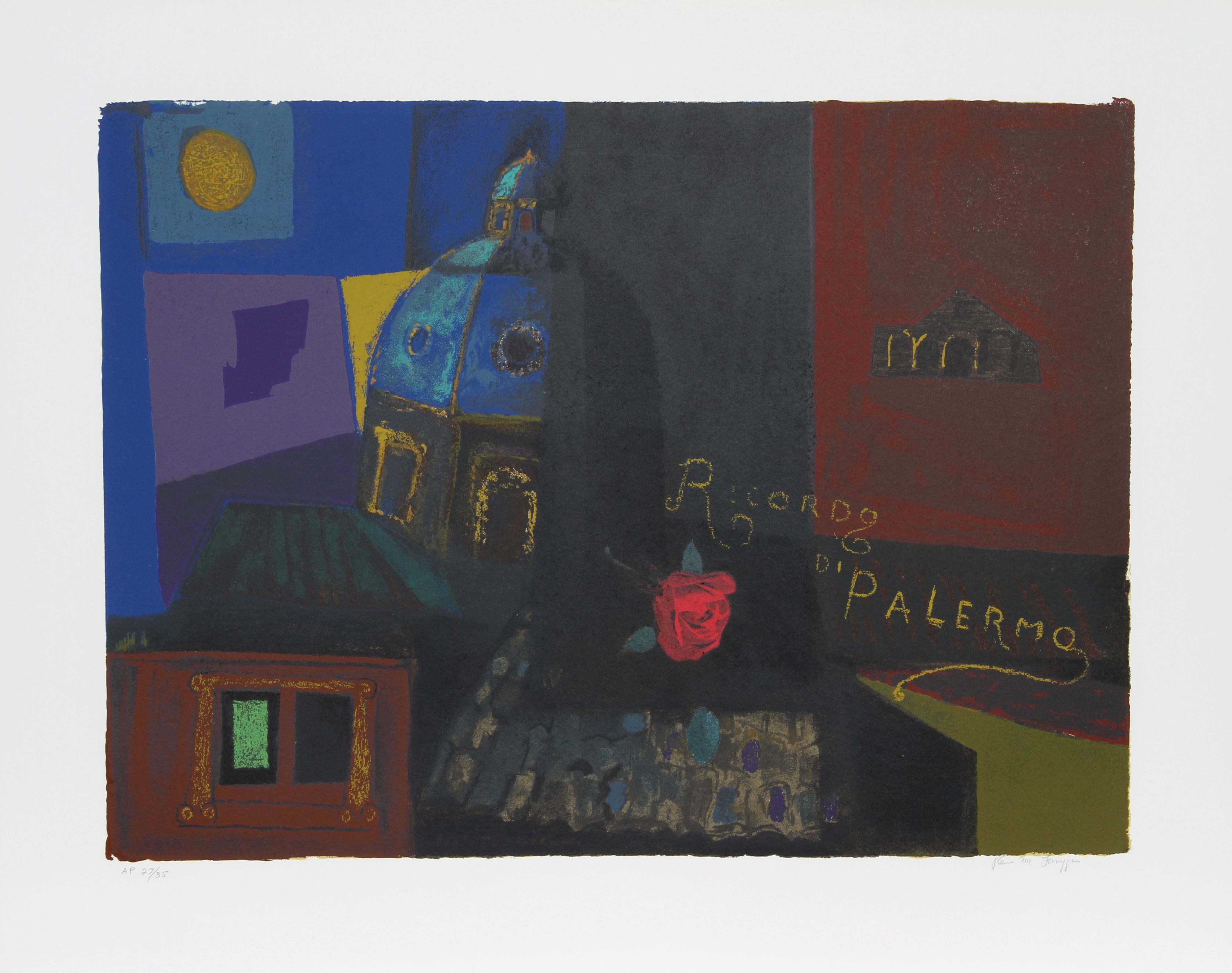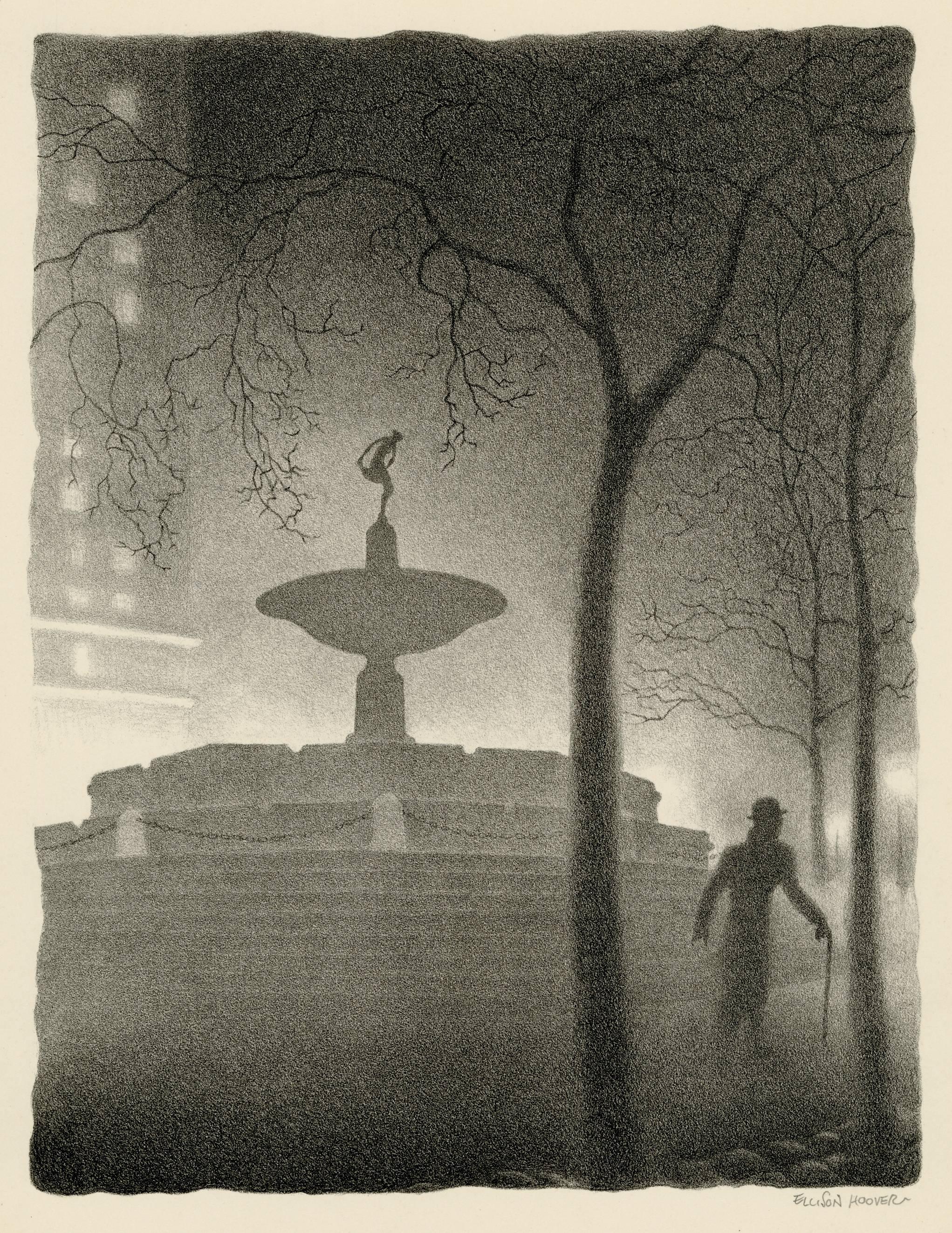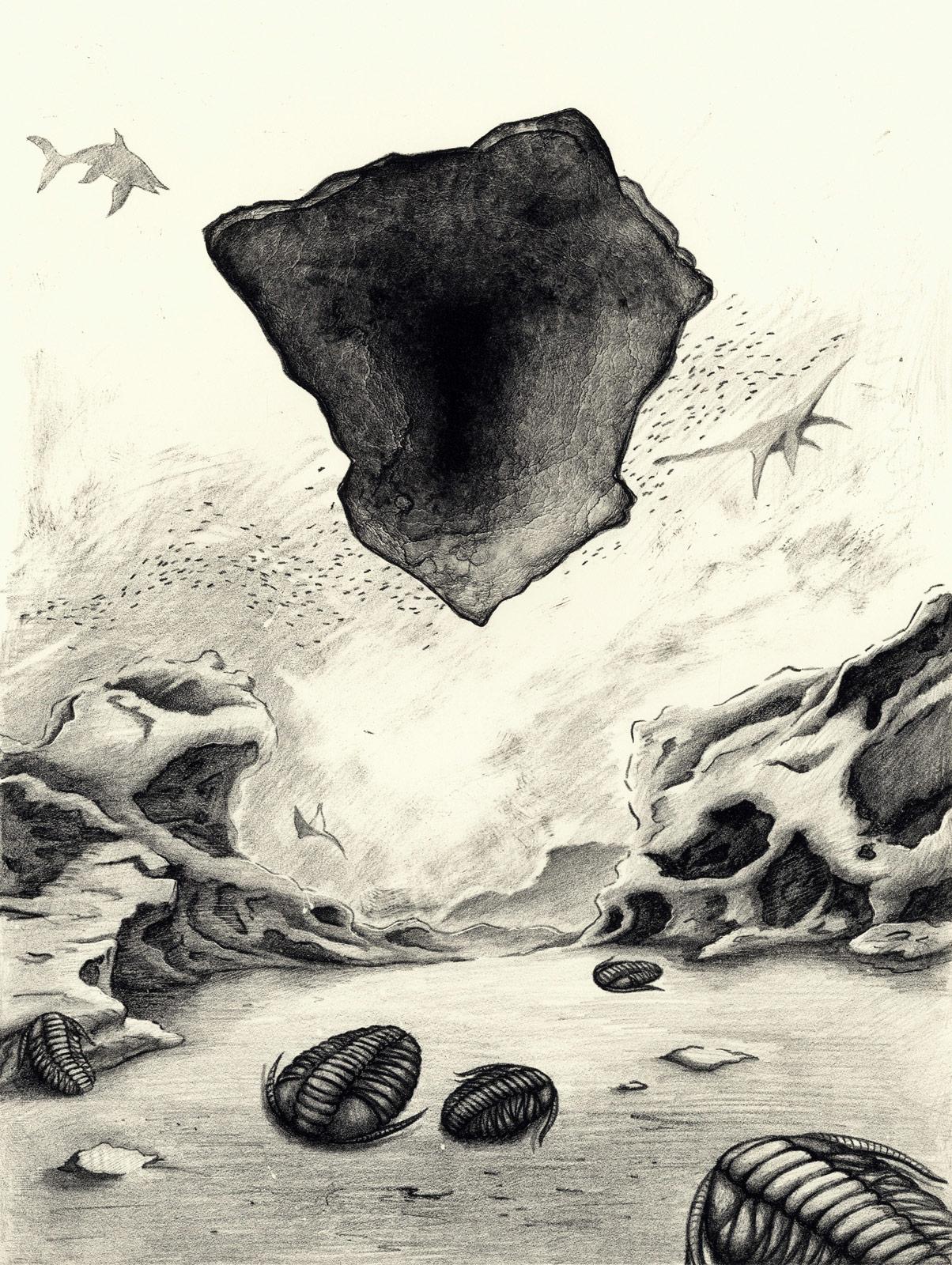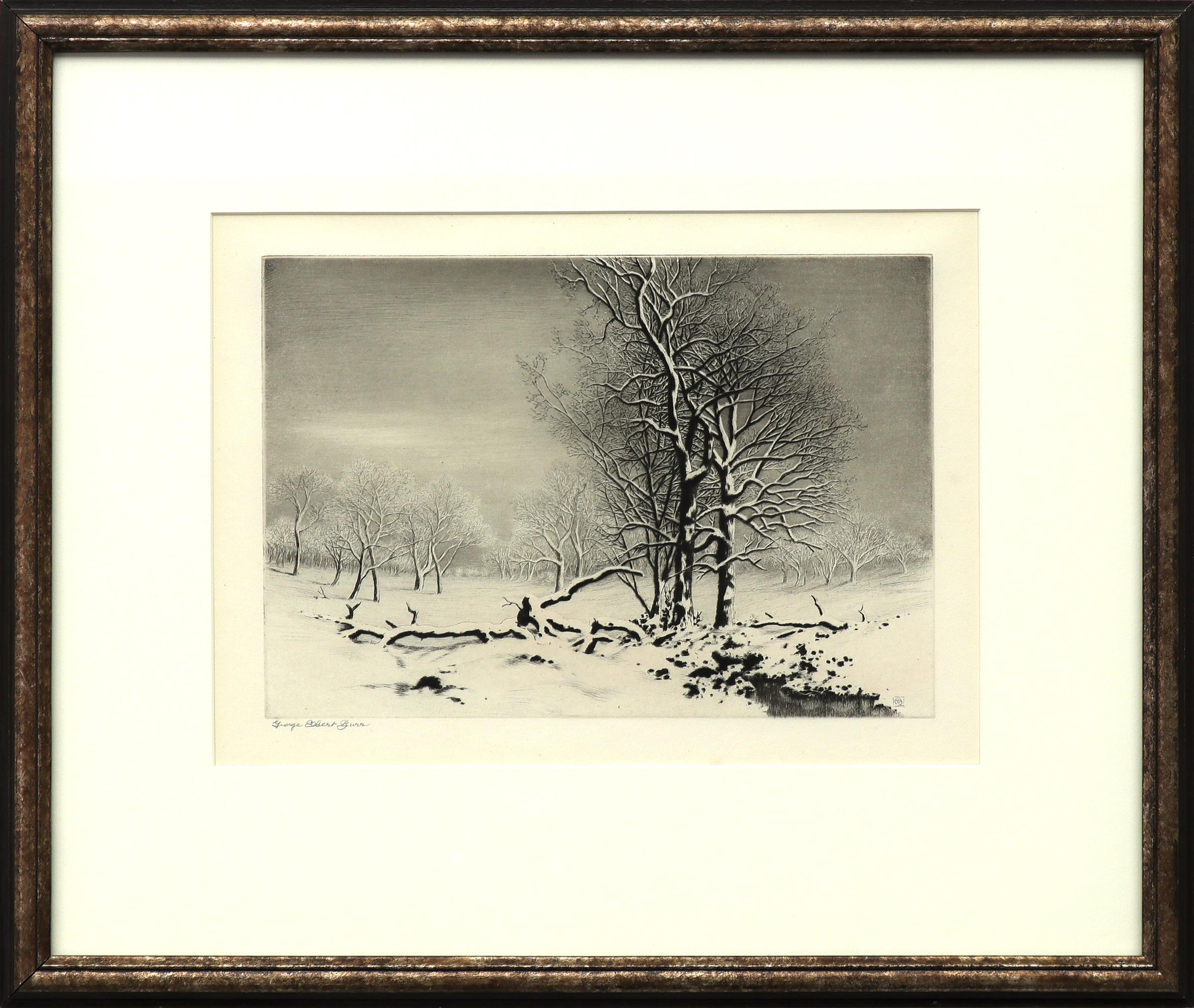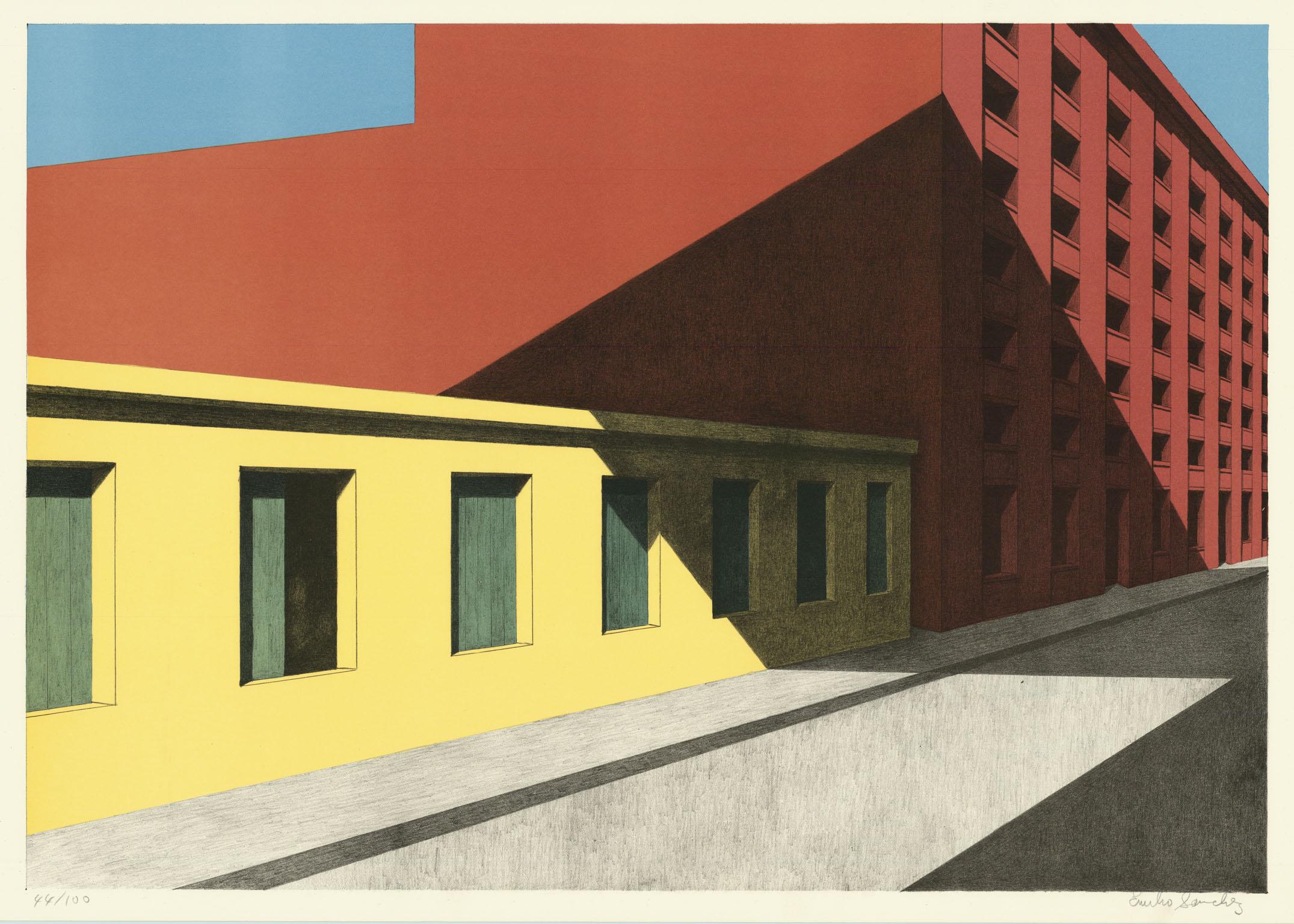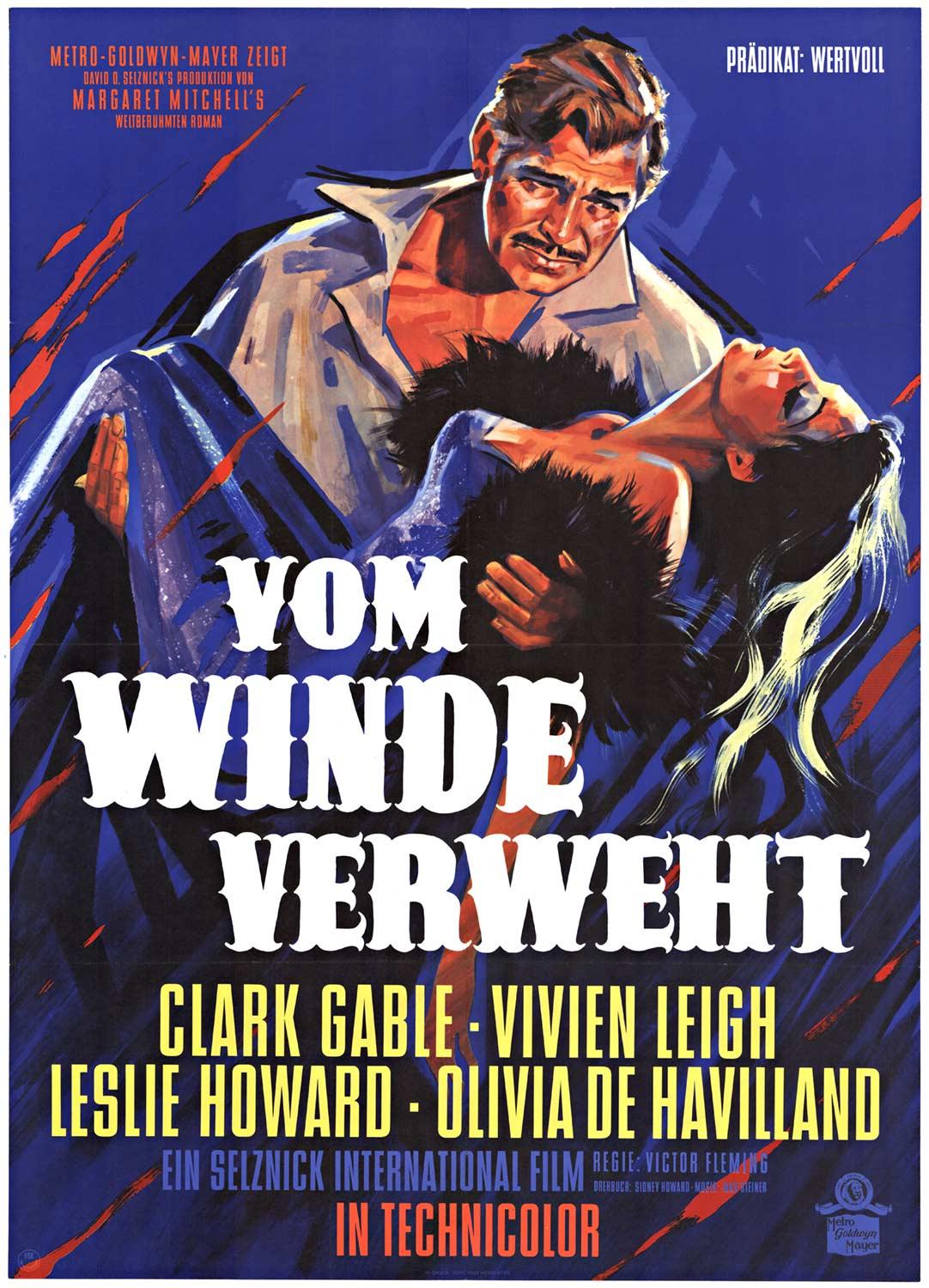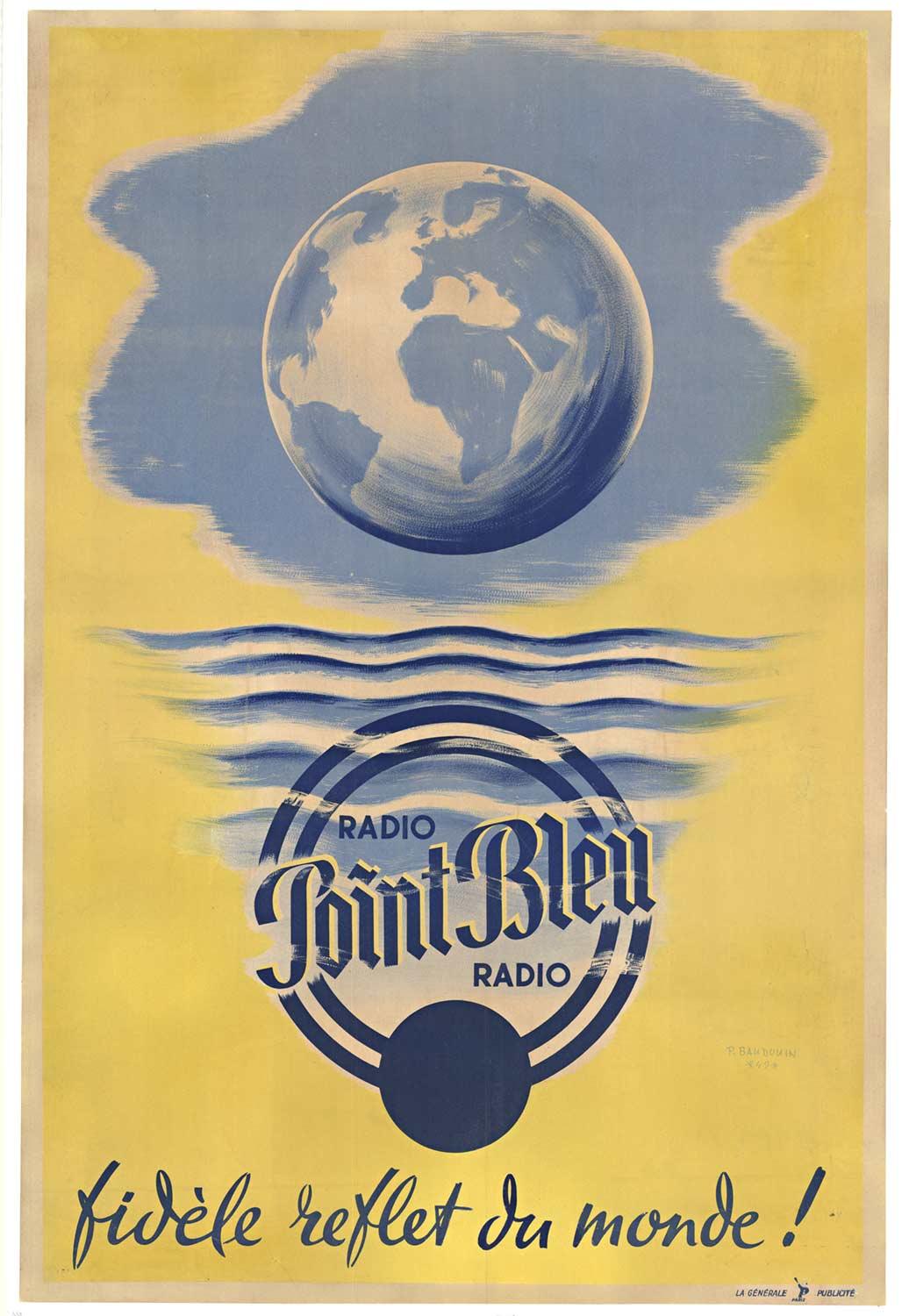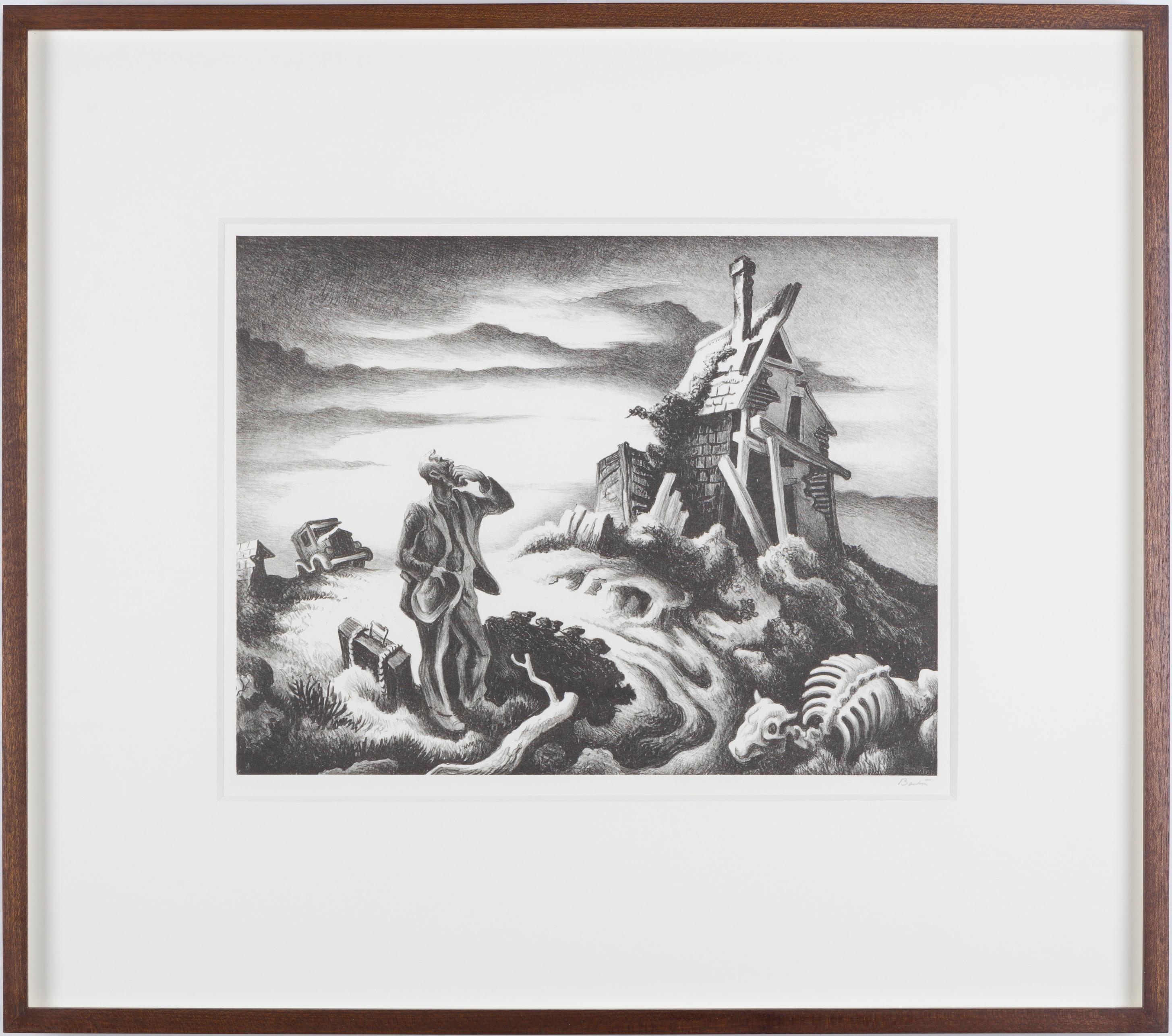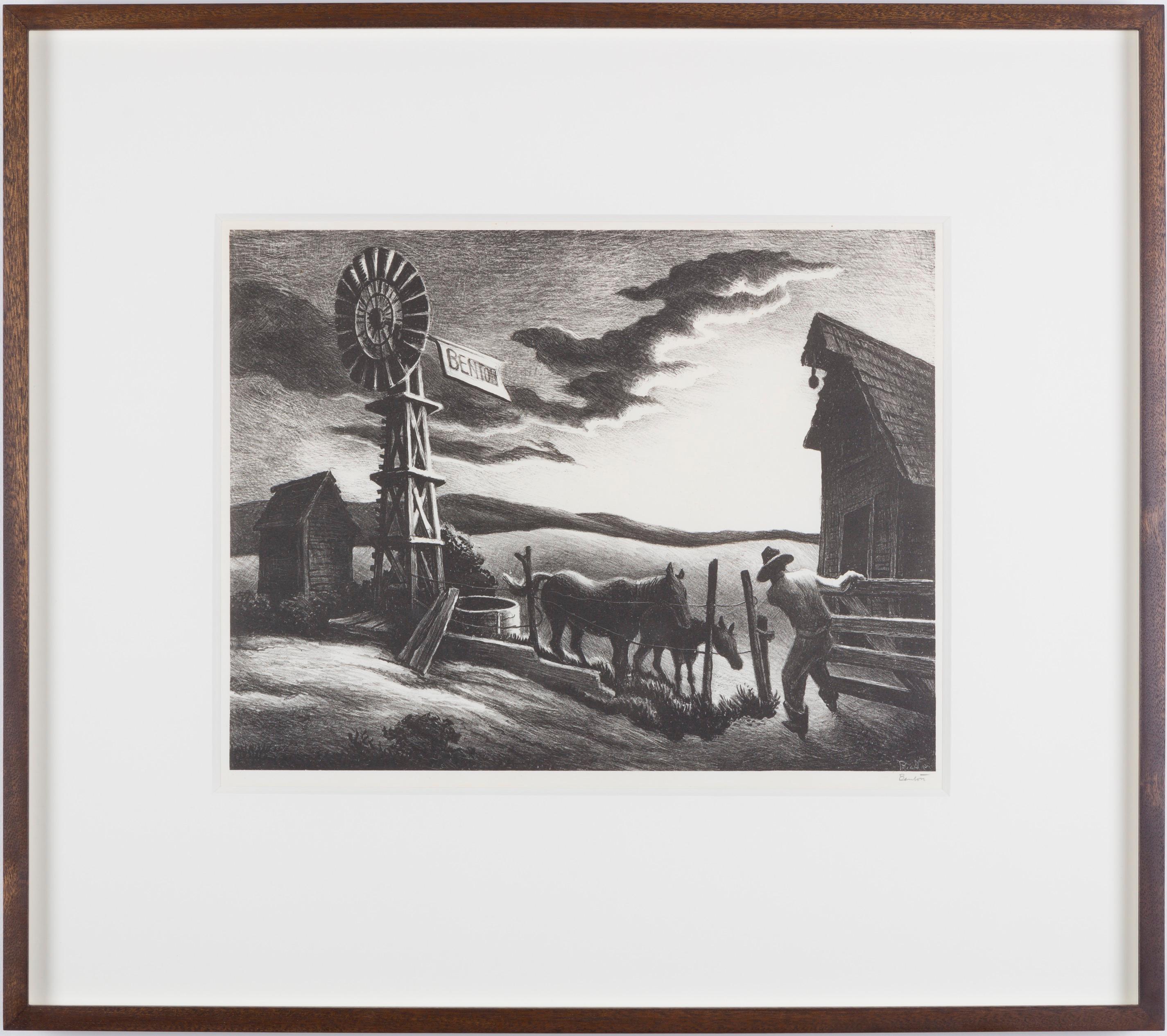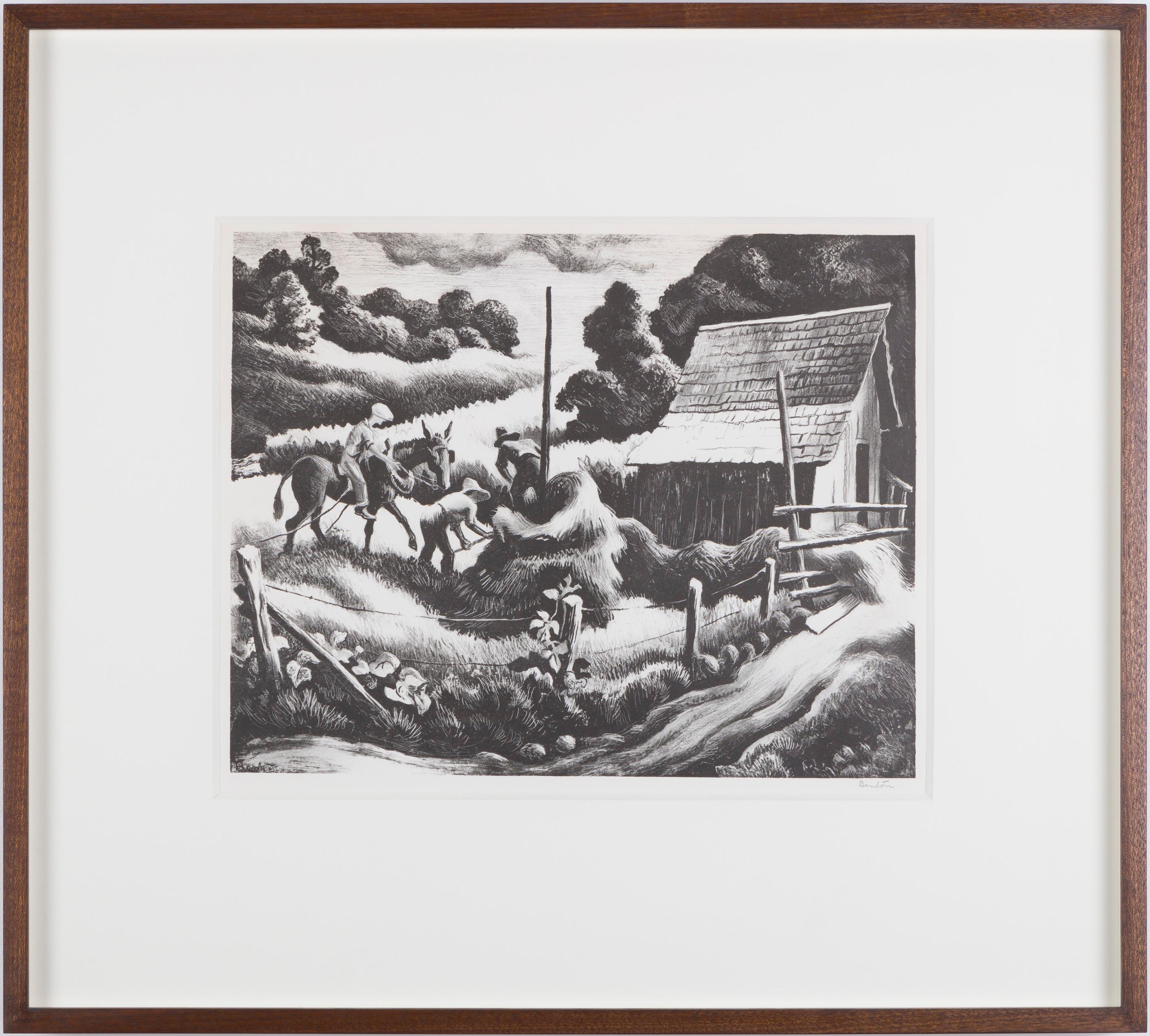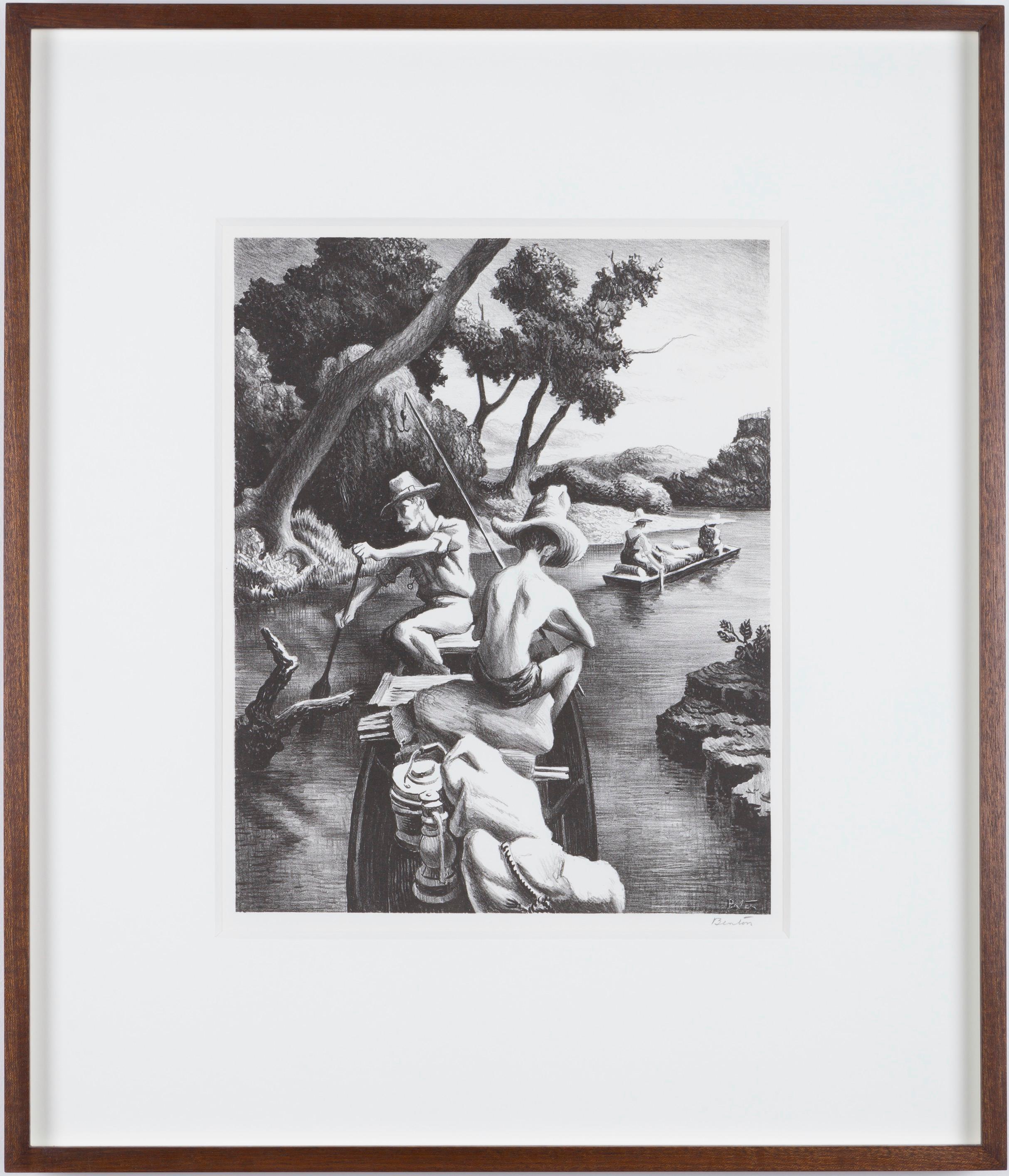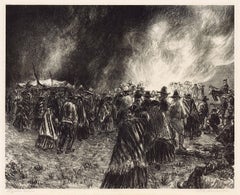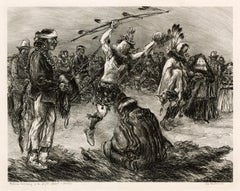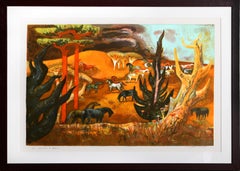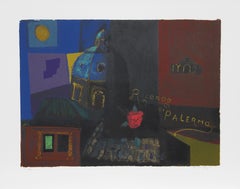
Madison Avenue
View Similar Items
Want more images or videos?
Request additional images or videos from the seller
1 of 3
Louis LozowickMadison Avenue1929
1929
About the Item
- Creator:Louis Lozowick (1892 - 1973, American)
- Creation Year:1929
- Dimensions:Height: 12.82 in (32.57 cm)Width: 8.88 in (22.56 cm)
- Medium:
- Movement & Style:
- Period:
- Condition:Reinforced skinning where a mounting hinge was removed in the top left sheet corner, verso.
- Gallery Location:Myrtle Beach, SC
- Reference Number:Seller: 1036141stDibs: LU53233820232
Louis Lozowick
Louis Lozowick is widely recognized as a key figure in America's Precisionist movement and a leader in mid-20th-century modernist printmaking. His graphic works and paintings have been acquired by numerous museums including the Art Institute of Chicago, Brooklyn Museum, Crystal Bridges Museum of American Art, Fine Arts Museums of San Francisco, Metropolitan Museum of Art, Museum of Modern Art, New York Public Library, Philadelphia Museum of Art, Smithsonian American Art Museum, U. S. Library of Congress and the Whitney Museum of American Art.
About the Seller
5.0
Recognized Seller
These prestigious sellers are industry leaders and represent the highest echelon for item quality and design.
Platinum Seller
These expertly vetted sellers are 1stDibs' most experienced sellers and are rated highest by our customers.
Established in 1995
1stDibs seller since 2016
256 sales on 1stDibs
Typical response time: 1 hour
Associations
International Fine Print Dealers Association
More From This SellerView All
- 'Pulitzer Fountain, Evening" — 1940s American Modernism, New York CityBy Ellison HooverLocated in Myrtle Beach, SCEllison Hoover, 'Pulitzer Fountain, Evening', lithograph, circa 1940, edition c. 40. Signed in pencil. A fine, atmospheric impression, on cream wove paper; the full sheet with margins (1 1/2 to 4 5/16 inches), in excellent condition. Archivally matted to museum standards, unframed. Image size 12 1/2 x 9 5/8 inches (318 x 244 mm); sheet size 16 1/4 x 12 1/4 inches (413 x 311 mm). ABOUT THE SUBJECT The Pulitzer fountain was commissioned as a bequest by Joseph Pulitzer, newspaper publisher and founder of the Columbia School of Journalism. Designed by Austrian sculptor Karl Bitter...Category
Mid-20th Century American Modern Landscape Prints
MaterialsLithograph
$1,760 Sale Price20% Off - 'Navajo Courtship Dance' — 1940s Southwest RegionalismBy Ira MoskowitzLocated in Myrtle Beach, SCIra Moskowitz, 'Navajo Courtship Dance (Squaw Dance)', lithograph, 1946, edition 30, Czestochowski 161. Signed and titled in pencil. Signed and dated in the stone, lower left. A fine, richly-inked impression, on cream wove paper; the full sheet with margins (7/16 to 2 3/4 inches). Pale mat line, otherwise in excellent condition. Matted to museum standards, unframed. Image size 11 13/16 x 14 13/16 inches (300 x 376 mm); sheet size 13 1/16 x 20 1/8 inches (332 x 511 mm). ABOUT THE ARTIST Ira Moskowitz was born in Galicia, Poland, in 1912, emigrating with his family to New York in 1927. He enrolled at the Art Student's League and studied there from 1928-31. In 1935, Moskowitz traveled to Paris and then lived until 1937 in what is now Israel. He returned to the United States in 1938 to marry artist Anna Barry in New York. The couple soon visited Taos and Santa Fe in New Mexico, returning for extended periods until 1944, when they moved there permanently, staying until 1949. During this especially productive New Mexico period, Moskowitz received a Guggenheim fellowship. His work was inspired by the New Mexico landscape and the state’s three cultures (American Southwest, Native American, and Mexican). He focused on Pueblo and Navajo life, producing an extensive oeuvre of authentic American Indian imagery. He and Anna also visited and sketched across the border in Old Mexico. While in the Southwest, Moskowitz flourished as a printmaker while continuing to produce oils and watercolors. Over 100 of Moskowitz’s works depicting Native American ceremonies were used to illustrate the book American Indian Ceremonial Dances by John Collier, Crown Publishers, New York, 1972. After leaving the Southwest, printmaking remained an essential medium for the artist while his focus changed to subject matter celebrating Judaic religious life and customs. These works were well received early on, and Moskowitz was content to stay with them the rest of his life. From 1963 until 1966, Moskowitz lived in Paris, returning to New York City in 1967, where he made his permanent home until he died in 2001. Shortly before his death, Zaplin-Lampert Gallery of Santa Fe staged an exhibition of the artist's works, December 2000 - January 2001. Other one-person shows included the 8th Street Playhouse, New York, 1934; Houston Museum, 1941; and the San Antonio Museum, 1941. The artist’s work was included in exhibitions at the Art Students League, Art Institute of Chicago, Philadelphia Print Club, College Art Association (promotes excellence in scholarship and teaching), and the International Exhibition of Graphic Arts (shown at MOMA, 1955). Moskowitz’s lithographs of...Category
1940s American Modern Landscape Prints
MaterialsLithograph
- 'Navajo Medicine Ceremony of the Night Chant' — 1940s Southwest RegionalismBy Ira MoskowitzLocated in Myrtle Beach, SCIra Moskowitz, 'The Three Gods of Healing (Navajo Medicine Ceremony of the Night Chant)', lithograph, 1945, edition 30, Czestochowski 148. Signed and titled in pencil. Signed and dated in the stone, lower right. A fine, richly-inked impression, on cream wove paper, with full margins (2 1/4 to 2 3/4 inches), in excellent condition. Matted to museum standards, unframed. Image size 12 1/4 x 15 13/16 inches (311 x 402 mm); sheet size 17 1/8 x 20 7/8 inches (435 x 530 mm). ABOUT THIS WORK The nine-night ceremony known as the Night Chant or Nightway is believed to date from around 1000 B.C.E. when it was first performed by the Indians who lived in Canyon de Chelly (now eastern Arizona). It is considered the most sacred of all Navajo ceremonies and one of the most difficult and demanding to learn, as it encompasses hundreds of songs, dozens of prayers, and several highly complex sand paintings. And yet the demand for Night Chants is so great that as many as fifty such ceremonies might be held during a single winter season, which lasts eighteen to twenty weeks. The Night Chant is designed both to cure people who are ill and to restore the order and balance of human and non-human relationships within the Navajo universe. Led by a trained medicine man who has served a long apprenticeship and learned the intricate and detailed practices that are essential to the chant, the ceremony itself is capable of scaring off sickness and ugliness through techniques that shock or arouse. Once the disorder has been removed, order and balance are restored through song, prayer, sand painting, and other aspects of the ceremony. The medicine men who supervise the Night Chant ensure that everything—each dot and line in every sand painting, each verse in every song, each feather on each mask is arranged precisely, or it will not bring about the desired result. There are probably as many active Night Chant medicine men today as at any time in Navajo history due to the general increase in the Navajo population, the popularity of the ceremony, and the central role it plays in Navajo life and health. ABOUT THE ARTIST Ira Moskowitz was born in Galicia, Poland, in 1912, emigrating with his family to New York in 1927. He enrolled at the Art Student's League and studied there from 1928-31. In 1935, Moskowitz traveled to Paris and then lived until 1937 in what is now Israel. He returned to the United States in 1938 to marry artist Anna Barry in New York. The couple soon visited Taos and Santa Fe in New Mexico, returning for extended periods until 1944, when they moved there permanently, staying until 1949. During this especially productive New Mexico period, Moskowitz received a Guggenheim fellowship. His work was inspired by the New Mexico landscape and the state’s three cultures (American Southwest, Native American, and Mexican). He focused on Pueblo and Navajo life, producing an extensive oeuvre of authentic American Indian imagery. He and Anna also visited and sketched across the border in Old Mexico. While in the Southwest, Moskowitz flourished as a printmaker while continuing to produce oils and watercolors. Over 100 of Moskowitz’s works depicting Native American ceremonies were used to illustrate the book American Indian Ceremonial Dances by John Collier, Crown Publishers, New York, 1972. After leaving the Southwest, printmaking remained an essential medium for the artist while his focus changed to subject matter celebrating Judaic religious life and customs. These works were well received early on, and Moskowitz was content to stay with them the rest of his life. From 1963 until 1966, Moskowitz lived in Paris, returning to New York City in 1967, where he made his permanent home until he died in 2001. Shortly before his death, Zaplin-Lampert Gallery of Santa Fe staged an exhibition of the artist's works, December 2000 - January 2001. Other one-person shows included the 8th Street Playhouse, New York, 1934; Houston Museum, 1941; and the San Antonio Museum, 1941. The artist’s work was included in exhibitions at the Art Students League, Art Institute of Chicago, Philadelphia Print Club, College Art Association (promotes excellence in scholarship and teaching), and the International Exhibition of Graphic Arts (shown at MOMA, 1955). Moskowitz’s lithographs of...Category
1940s American Modern Landscape Prints
MaterialsLithograph
- 'Navajo Horse Race' — 1940s Southwest RegionalismBy Ira MoskowitzLocated in Myrtle Beach, SCIra Moskowitz, 'Navajo Horse Race', lithograph, 1946, edition 30, Czestochowski 204. Signed and titled in pencil. Signed and dated in the stone, lower le...Category
1940s American Modern Landscape Prints
MaterialsLithograph
- 'Taos - Relic of the Insurrection of 1845' — 1940s Southwest RegionalismBy Ira MoskowitzLocated in Myrtle Beach, SCIra Moskowitz, 'Relic of the Insurrection of 1845' also 'Taos Pueblo with Ruin)', lithograph, 1944, edition 30, Czestochowski 121. Signed and titled in pencil. Signed and dated in the stone, lower right. A fine, richly-inked impression, on cream wove paper, with full margins (1 3/8 to 1 15/16 inches). Very pale light toning within a previous mat opening, otherwise in excellent condition. Matted to museum standards, unframed. Image size 11 5/8 x 15 1/2 inches (296 x 394 mm); sheet size 15 1/8 x 19 inches (384 x 483 mm). ABOUT THE IMAGE The Taos Revolt was a populist insurrection in January 1847 by Hispano and Pueblo allies against the United States occupation of present-day northern New Mexico during the Mexican–American War. The rebels killed provisional governor Charles Bent and several other Americans. In two short campaigns, United States troops and militia crushed the rebellion of the Hispano and Pueblo people. The New Mexicans, seeking better representation, regrouped and fought three more engagements, but after being defeated, they abandoned open warfare. The hatred of New Mexicans for the occupying American army, combined with the rebelliousness of Taos residents against imposed outside authority, were causes of the revolt. In the uprising's aftermath, the Americans executed at least 28 rebels. The Treaty of Guadalupe Hidalgo in 1850 guaranteed the property rights of New Mexico's Hispanic and American Indian residents. ABOUT THE ARTIST Ira Moskowitz was born in Galicia, Poland, in 1912, emigrating with his family to New York in 1927. He enrolled at the Art Student's League and studied there from 1928-31. In 1935, Moskowitz traveled to Paris and then lived until 1937 in what is now Israel. He returned to the United States in 1938 to marry artist Anna Barry in New York. The couple soon visited Taos and Santa Fe in New Mexico, returning for extended periods until 1944, when they moved there permanently, staying until 1949. During this especially productive New Mexico period, Moskowitz received a Guggenheim fellowship. His work was inspired by the New Mexico landscape and the state’s three cultures (American Southwest, Native American, and Mexican). He focused on Pueblo and Navajo life, producing an extensive oeuvre of authentic American Indian imagery. He and Anna also visited and sketched across the border in Old Mexico. While in the Southwest, Moskowitz flourished as a printmaker while continuing to produce oils and watercolors. Over 100 of Moskowitz’s works depicting Native American ceremonies were used to illustrate the book American Indian Ceremonial Dances by John Collier, Crown Publishers, New York, 1972. After leaving the Southwest, printmaking remained an essential medium for the artist while his focus changed to subject matter celebrating Judaic religious life and customs. These works were well received early on, and Moskowitz was content to stay with them the rest of his life. From 1963 until 1966, Moskowitz lived in Paris, returning to New York City in 1967, where he made his permanent home until he died in 2001. Shortly before his death, Zaplin-Lampert Gallery of Santa Fe staged an exhibition of the artist's works, December 2000 - January 2001. Other one-person shows included the 8th Street Playhouse, New York, 1934; Houston Museum, 1941; and the San Antonio Museum, 1941. The artist’s work was included in exhibitions at the Art Students League, Art Institute of Chicago, Philadelphia Print Club, College Art Association (promotes excellence in scholarship and teaching), and the International Exhibition of Graphic Arts (shown at MOMA, 1955). Moskowitz’s lithographs of American Indian...Category
1940s American Modern Landscape Prints
MaterialsLithograph
- 'Navajo Trading Post' — 1940s Southwest RegionalismBy Ira MoskowitzLocated in Myrtle Beach, SCIra Moskowitz, 'Navajo Trading Post', lithograph, 1946, edition 30, Czestochowski 161. Signed and dated in the stone, lower left. A fine, richly-inked impression, on cream wove paper, with full margins (1 1/2 to 3 1/8 inches). Pale mat line, otherwise in excellent condition. Matted to museum standards, unframed. Image size 11 11/16 x 15 1/2 inches (297 x 395 mm); sheet size 16 5/16 x 191/8 inches (414 x 486 mm). ABOUT THE ARTIST Ira Moskowitz was born in Galicia, Poland, in 1912, emigrating with his family to New York in 1927. He enrolled at the Art Student's League and studied there from 1928-31. In 1935, Moskowitz traveled to Paris and then lived until 1937 in what is now Israel. He returned to the United States in 1938 to marry artist Anna Barry in New York. The couple soon visited Taos and Santa Fe in New Mexico, returning for extended periods until 1944, when they moved there permanently, staying until 1949. During this especially productive New Mexico period, Moskowitz received a Guggenheim fellowship. His work was inspired by the New Mexico landscape and the state’s three cultures (American Southwest, Native American, and Mexican). He focused on Pueblo and Navajo life, producing an extensive oeuvre of authentic American Indian imagery. He and Anna also visited and sketched across the border in Old Mexico. While in the Southwest, Moskowitz flourished as a printmaker while continuing to produce oils and watercolors. Over 100 of Moskowitz’s works depicting Native American ceremonies were used to illustrate the book American Indian Ceremonial Dances by John Collier, Crown Publishers, New York, 1972. After leaving the Southwest, printmaking remained an essential medium for the artist while his focus changed to subject matter celebrating Judaic religious life and customs. These works were well received early on, and Moskowitz was content to stay with them the rest of his life. From 1963 until 1966, Moskowitz lived in Paris, returning to New York City in 1967, where he made his permanent home until he died in 2001. Shortly before his death, Zaplin-Lampert Gallery of Santa Fe staged an exhibition of the artist's works, December 2000 - January 2001. Other one-person shows included the 8th Street Playhouse, New York, 1934; Houston Museum, 1941; and the San Antonio Museum, 1941. The artist’s work was included in exhibitions at the Art Students League, Art Institute of Chicago, Philadelphia Print Club, College Art Association (promotes excellence in scholarship and teaching), and the International Exhibition of Graphic Arts (shown at MOMA, 1955). Moskowitz’s lithographs of American Indian...Category
1940s American Modern Landscape Prints
MaterialsLithograph
You May Also Like
- Summer GoldBy Millard SheetsLocated in Long Island City, NYArtist: Millard Owen Sheets, American (1907 - 1989) Title: Summer Gold Medium: Lithograph, signed and numbered in pencil Edition: 250, 5 HC Image S...Category
1970s American Modern Animal Prints
MaterialsLithograph
- Mediterranean, Lithograph by Remo FarruggioBy Remo Michael FarruggioLocated in Long Island City, NYMediterranean Remo Farruggio, Italian/American (1904–1981) Date: Circa 1979 Lithograph, signed and numbered in pencil Edition of 300, AP 35 Image Size: 21 x 29 inches Size: 28 in. x ...Category
1980s American Modern Landscape Prints
MaterialsLithograph
- Prehistoric Sighting Pacific Ocean (Goblin Sharks?)Located in New Orleans, LAThis is a single color lithograph created by Matthew Roath as part of Tamarind Institute PTP. The Collaborating printer isAndreea Cristina Mateescu....Category
21st Century and Contemporary American Modern Landscape Prints
MaterialsLithograph
$83 Sale Price58% Off - Original Signed Lithograph Print of a Winter Landscape with Snow and TreesBy George Elbert BurrLocated in Denver, COOriginal signed lithograph print signed by George Elbert Burr (1859-1939) of a winter landscape with snow and trees. Presented in a custom frame with archival materials measuring 15 x 17 ¾ inches. Image size measures 7 ¼ x 10 ¼ inches. About the Artist: Born Ohio 1859 Died Arizona 1939 Ten years after his birth in Monroe Falls, Ohio, George Elbert Burr moved with his parents to Cameron, Missouri, where his father opened a hardware store. Burr was interested in art from an early age and his first etchings were created with the use of zinc scraps found in the spark pan under the kitchen stove. He then printed the plates on a press located in the tin shop of his father’s store. In December of 1878, Burr left for Illinois to attend the Art Institute of Chicago (then called the Chicago Academy of Design). By April of the following year, Burr had moved back to Missouri. The few months of study in Chicago constituted the only formal training the artist was to have. Back in Missouri, Burr heeded his family’s wishes by working in his father’s store. However, he did not abandon his art, often using his father’s railway pass to travel around the countryside on sketching trips. In 1894, Burr married Elizabeth Rogers and the following year he became an instructor for a local drawing class. By 1888, the artist was employed as an illustrator for Scribner’s, Harper’s, and The Observer. In 1892, Burr began a four-year project to illustrate a catalog for the Metropolitan Museum of Art of Heber R. Bishop’s jade collection. After completing approximately 1,000 etchings of the collection, Burr used the money he earned on the project to fund a trip abroad. The artist and his wife spent the years between 1896 and 1901 sketching and traveling on a tour of Europe that spanned from Sicily to North Wales. In 1906 the couple moved to Denver, Colorado, in an effort to improve George’s poor health. While in Colorado, Burr completed Mountain Moods, a series of 16 etchings. His years in Denver were highly productive despite his poor health. Burr’s winters were spent traveling through the deserts of Southern California, Arizona, and New Mexico. In 1921, Burr obtained copyrights on the last of 35 etchings included in his well-known Desert Set...Category
20th Century American Modern Landscape Prints
MaterialsLithograph
- Shadow of the Brooklyn Bridge.By Emilio SanchezLocated in New York, NY“THE SHADOW OF THE BROOKLYN BRIDGE” Emilio Sanchez (1921-1999) created this color lithograph entitled “Shadow of the Brooklyn Bridge” in 1988. The image size is 21.38 x 30.50 inche...Category
Late 20th Century American Modern Landscape Prints
MaterialsLithograph
- Original 'Gone with the Wind" vintage German movie posterLocated in Spokane, WAOriginal Gone with the Wind “Vom Winde Verweht” vintage lithograph poster. Original vintage movie poster with professional acid-free linen backing; excellent condition; ready to frame. This is the German 1962 release of Gone with the Wind, printed in the full lithographic style of the old French posters. Unique imagery of the famous scene of the burning of Atlanta. Starring Clark Gable, Vivien Leigh, Leslie Howard, Olivia de Havilland...Category
1860s American Modern Portrait Prints
MaterialsLithograph

